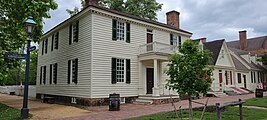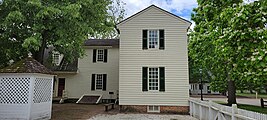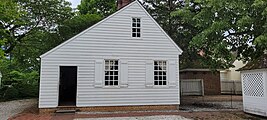| Geddy House | |
|---|---|
 | |
| Alternative names | James Geddy House |
| General information | |
| Status | Museum |
| Town or city | Williamsburg, Virginia |
| Country | United States |
| Coordinates | 37°16′17″N 76°42′06″W / 37.27137°N 76.70159°W / 37.27137; -76.70159 |
| Named for | James Geddy, Jr. |
| Construction started | 1762 |
| Renovated | 1930 |
| Owner | Colonial Williamsburg |
| Technical details | |
| Floor count | Two |
| Website | |
| Colonial Williamsburg Geddy House | |
The Geddy House, also known as the James Geddy House, was built by James Geddy Jr. ca. 1762. One of the oldest houses in Virginia and in Williamsburg, it is located on the Palace Green across from Bruton Parish Church. It is a two-story, central-passage house.
History
James Geddy Jr. was a well-established silversmith in Williamsburg. Advertisements in the late 1760s indicate that Geddy's business sold imported silver and gold items, in addition to fine jewelry and cutlery.
In 1762, Geddy built the house at the corner of Duke of Gloucester Street and Palace Green. In addition to serving as the family home, the structure also housed the various business ventures of the Geddy family utilizing a rear entrance as a retail shop.
During restorations of Colonial Williamsburg in 1930 and 1967, the entrance porch was replaced, and the house's chimneys were rebuilt above the roof ridge. The house retains much of its original woodwork. Further preservation activities were undertaken in 2002.
Features
Many aspects of the house's design are not common in other sites in Williamsburg. The house's low-pitched roof and lack of dormers are unusual features, as are the door and balcony above the front porch. The L-shape may have also been adapted to fit the location.
The details of the home include English architecture and Italian variations of Greek and Roman architecture. Archeological excavations of the shop site of the house have provided information about eighteenth-century clockmaking in British America.
Gallery
References
- "Historic Site: James Geddy House". www.colonialwilliamsburg.org. Retrieved 2023-08-12.
- Foundation, The Colonial Williamsburg (2011-01-01). Colonial Williamsburg: A Pocket Guide. Colonial Williamsburg. ISBN 978-0-87935-248-6.
- Beney, Peter (1997-11-30). The Majesty of Colonial Williamsburg. Pelican Publishing. ISBN 978-1-4556-0814-0.
- ^ "James Geddy House". www.slaveryandremembrance.org. Retrieved 2023-08-12.
- "James Geddy House Historical Report Block 19 Building 11 Lots 161 & 162 | Colonial Williamsburg Digital Library". research.colonialwilliamsburg.org. Retrieved 2023-08-12.
- ^ "James Geddy Jr.: Silversmithing and Retail Business". www.slaveryandremembrance.org. Retrieved 2023-08-12.
- Stephenson, Mary A. (1953). James Geddy House.
- Morgan, Timothy E. (2004). Williamsburg: A City that History Made. Arcadia Publishing. ISBN 978-0-7385-2473-3.
- pls4e (2019-03-27). "James Geddy House". SAH ARCHIPEDIA. Retrieved 2023-08-12.
{{cite web}}: CS1 maint: numeric names: authors list (link) - "Geddy House and Foundry - site description". www.slaveryandremembrance.org. Retrieved 2023-08-12.
- Foundation, The Colonial Williamsburg (2014-12-08). Colonial Williamsburg: The Official Guide. Colonial Williamsburg. ISBN 978-0-87935-265-3.
- Taylor, Thomas H. (2002). Planned Preservation Project Completion Report James Geddy House.
- ^ Yetter, George Humphrey (1988). Williamsburg Before and After: The Rebirth of Virginia's Colonial Capital. Colonial Williamsburg. ISBN 978-0-87935-077-2.
- Hume, Ivor Noël (2001-06-15). A Guide to the Artifacts of Colonial America. University of Pennsylvania Press. ISBN 978-0-8122-1771-1.
| Colonial Williamsburg | |
|---|---|
| History | |
| Structures |
|
| People | |
| Geography | |
| Other | |


